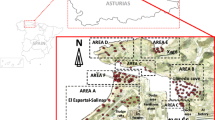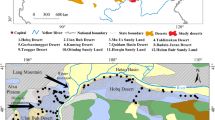Abstract
The chemical composition of sediments is controlled predominantly by the sediment grain size, and thus evaluating their relationship is an important task in sedimentary geochemistry. The grain size is characterized by the respective particle size distribution, which can be expressed as a probability density function. Because of the relative character of densities, the Bayes space methodology was employed to build a regression model between a real response and a density function as a covariate, here the chemical composition and the particle size density. For practical computations, density functions were expressed in the standard \(L^2\) space using the centred logratio transformation and spline approximation of the input discretized densities was utilized by respecting the induced zero-integral constraint. After a concise simulation study, supporting the relevance of the proposed regression model, the new methodology was applied to examine the relationship between sediment grain size and geochemical composition, with samples being obtained in the Czech Republic in the Skalka Reservoir and in the Ohře River floodplain upstream of the reservoir, to reveal proper grain size proxies. The Al/Si and Zr/Rb logratios in the sediments that were studied showed grain-size control, which makes them suitable for this purpose.








Similar content being viewed by others
Availability of data and materials
Data are available from the authors on request.
References
Aitchison J (1986) The statistical analysis of compositional data. Chapman and Hall, London
Bloemsma M, Zabel M, Stuut J, Tjallingii R, Collins JA, Weltje GJ (2012) Modelling the joint variability of grain size and chemical composition in sediments. Sed Geol 280:135–148
Bouchez J, Gaillardet J, France-Lanord C, Bourgoin L, Maia P (2011) Grain size control of river suspended sediment geochemistry: Clues from Amazon River depth profiles. Geochem Geophys Geosyst 12:Q03008
Cai T, Hall P (2006) Prediction in functional linear regression. Ann Stat 34:2159–2179
Capezza C, Lepore A, Menafoglio A, Palumbo B, Vantini S (2020) Control charts for monitoring ship operating conditions and \(\text{CO}_2\) emissions based on scalar-on-function regression. Appl Stoch Models Bus Ind 36(3):477–500
Cardot H, Ferraty F, Sarda P (1999) Functional linear model. Stat Probab Lett 45:11–22
Cardot H, Ferraty F, Sarda P (2003a) Spline estimators for the functional linear model. Stat Sin 13:571–591
Cardot H, Ferraty F, Sarda P, Toulouse R (2003b) Spline estimators for the functional linear model. Stat Sin 13:571–591
Chen J, Chen Y, Liu L, Ji J, Balsam W, Sun Y, Lu H (2006) Zr/Rb ratio in the Chinese loess sequences and its implication for changes in the East Asian winter monsoon strength. Geochimica et Cosmochimica Acta 70:1471–1482
De Boor C (1978) A practical guide to splines. Springer, New York
Dierckx P (1995) Curve and surface fitting with splines. Oxford University Press, Oxford
Egozcue JJ, Díaz-Barrero JL, Pawlowsky-Glahn V (2006) Hilbert space of probability density functions based on Aitchison geometry. Acta Math Sin 22(4):1175–1182
Febrero-Bande M, Galeano P, González-Manteiga W (2010) Measures of influence for the functional linear model with scalar response. J Multivar Anal 101(2):327–339
Filzmoser P, Hron K, Templ M (2018) Applied compositional data analysis. Springer, Cham
Fišerová E, Donevska S, Hron K, Bábek O, Vaňkátová K (2016) Element enrichment factor calculation using grain-size distribution and functional data regression. Meas Sci Rev 16(5):235–243
Flood R, Bloemsma M, Weltje G, Barr I, O’Rourke S, Turner J, Orford J (2016) Compositional data analysis of holocene sediments from the West Bengal Sundarbans, India: geochemical proxies for grain-size variability in a delta environment. Appl Geochem 75:222–235
Gärtner A, Linnemann U, Sagawe A, Hofmann M, Ullrich B, Kleber A (2013) Morphology of zircon crystal grains in sediments—characteristics, classifications, definitions. Geol Saxonica 59:65–73
Hošek M, Bednárek J, Popelka J, Elznicová J, T\(\mathring{\rm u}\)mová Š, Rohovec J, Navrátil T, Matys Grygar T (2020) Persistent mercury hot spot in Central Europe and Skalka Dam Reservoir as a long-term mercury trap. Environ Geochem Health 42:1273–1290
Hron K, Menafoglio A, Templ M, Hr\(\mathring{\rm u}\)zová K, Filzmoser P (2016) Simplicial principal component analysis for density functions in Bayes spaces. Comput Stat Data Anal 94:330–350
Liu D, Bertrand S, Weltje G (2019) An empirical method to predict sediment grain size from inorganic geochemical measurements. Geochem Geophys Geosyst 20:3690–3704
Machalová J, Hron K, Monti GS (2016) Preprocessing of centred logratio transformed density functions using smoothing splines. J Appl Stat 43(8):1419–1435
Machalová J, Talská R, Hron K, Gába A (2021) Compositional splines for representation of density functions. Comput Stat. https://doi.org/10.1007/s00180-020-01042-7
Matys Grygar T, Popelka J (2016) Revisiting geochemical methods of distinguishing natural concentrations and pollution by risk elements in fluvial sediments. J Geochem Explor 170:39–57
Matys Grygar T, Elznicová J, Kiss T, Smith H (2016) Using sedimentary archives to reconstruct pollution history and sediment provenance: the Ohře River, Czech Republic. Catena 144:109–129
Matys Grygar T, Hošek M, Pacina J, Štojdl J, Bábek O, Sedláček J, Hron K, Talská R, Kříženecká S, Tolaszová J (2018) Changes in the geochemistry of fluvial sediments after dam construction (the Chrudimka River, the Czech Republic). Appl Geochem 98:94–108
Matys Grygar T, Mach K, Martinez M (2019) Checklist for the use of potassium concentrations in siliciclastic sediments as paleoenvironmental archives. Sed Geol 382:75–84
Menafoglio A, Guadagnini A, Secchi P (2014) A kriging approach based on Aitchison geometry for the characterization of particle-size curves in heterogeneous aquifers. Stoch Env Res Risk Assess 28(7):1835–1851
Menafoglio A, Guadagnini A, Secchi P (2016a) Stochastic simulation of soil particle-size curves in heterogeneous aquifer systems through a Bayes space approach. Water Resour Res 52(8):5708–5726
Menafoglio A, Secchi P, Guadagnini A (2016b) A class-kriging predictor for functional compositions with application to particle-size curves in heterogeneous aquifers. Math Geosci 48(4):463–485
Menafoglio A, Grasso M, Secchi P, Colosimo B (2018) Profile monitoring of probability density functions via simplicial functional PCA with application to image data. Technometrics 60(4):497–510
Morris J (2015) Functional regression. Annu Rev Stat Appl 2:321–359
Ordóñez C, Sierra C, Albuquerque T, Gallego J (2013) Functional data analysis as a tool to correlate textural and geochemical data. Appl Math Comput 223:476–482
Pacina J, Lendáková Z, Štojdl J, Matys Grygar T, Dolejš M (2020) Dynamics of sediments in reservoir inflows: a case study of the Skalka and Nechranice reservoirs, Czech Republic. ISPRS Int J Geo-Inf 9:258
Pawlowsky-Glahn V, Egozcue JJ, Tolosana-Delgado R (2015) Modeling and analysis of compositional data. Wiley, Chichester
Ramsay J, Silverman B (2005) Functional data analysis, 2nd edn. Springer, New York
Reiss P, Goldsmith J, Shang H, Ogden R (2018) Methods for scalar-on-function regression. Int Stat Rev 85(2):228–249
Sierra C, Ordóñez C, Saavedra A, Gallego J (2015) Element enrichment factor calculation using grain-size distribution and functional data regression. Chemosphere 119:1192–1199
Talská R, Menafoglio A, Machalová J, Hron K, Fišerová E (2018) Compositional regression with functional response. Comput Stat Data Anal 123:66–85
Talská R, Menafoglio A, Hron K, Egozcue JJ, Palarea-Albaladejo J (2020) Weighting the domain of probability densities in functional data analysis. Stat 9(1):e283
Tekbudak M, Alfaro-Cordoba M, Maity A, Staicu A (2019) A comparison of testing methods in scalar-on-function regression. ASTA Adv Stat Anal 103(3):411–436
Tekwe C, Zoh R, Yang M, Carroll R, Honvoh G, Allison D, Benden M, Xue L (2019) Instrumental variable approach to estimating the scalar-on-function regression model with measurement error with application to energy expenditure assessment in childhood obesity. Stat Med 38(20):3764–3781
Tolosana-Delgado R, von Eynatten H (2009) Grain-size control on petrographic composition of sediments: compositional regression and rounded zeroes. Math Geosci 41(8):869–886
Tolosana-Delgado R, von Eynatten H (2010) Simplifying compositional multiple regression: application to grain size controls on sediment geochemistry. Comput Geosci 36:577–589
van den Boogaart KG, Egozcue JJ, Pawlowsky-Glahn V (2014) Bayes Hilbert spaces. Austr N Z J Stat 56(2):171–194
van den Boogaart K, Filzmoser P, Hron K, Templ M, Tolosana-Delgado R (2021) Classical and robust regression analysis with compositional data. Math Geosci. https://doi.org/10.1007/s11004-020-09895-w
von Eynatten H, Tolosana-Delgado R, Karius V (2012) Sediment generation in modern glacial settings: grain-size and source-rock control on sediment composition. Sed Geol 280:80–92
von Eynatten H, Tolosana-Delgado R, Karius V, Bachmann K, Caracciolo L (2016) Sediment generation in humid Mediterranean setting: grain-size and source-rock control on sediment geochemistry and mineralogy (Sila Massif, Calabria). Sed Geol 336:68–80
Acknowledgements
The authors gratefully acknowledge the support of the Czech Science Foundation GA19-01768S.
Author information
Authors and Affiliations
Contributions
RT and KH conceived this research and designed the experiments; TMG provided the geochemical dataset and interpretations; RT performed the experiments and analysis; RT wrote the first draft of the paper and RT, KH and TMG all participated in the revisions of it. All authors read and approved the final manuscript.
Corresponding author
Ethics declarations
Conflict of interest
The authors declare that they have no conflict of interest.
Appendix: Computation of ZB-Spline Coefficients
Appendix: Computation of ZB-Spline Coefficients
In this appendix, the computation of ZB-spline coefficients for a smoothing spline from the \(L_0^2\) space is briefly recalled; for more details see Machalová et al. (2021). Let data \((t_{j},f_{j})\), \(a\le t_{j}\le b\), weights \(w_{j}>0\), \(j=1,\ldots ,n\), \(n\ge g+1\) and a parameter \(\alpha \in (0,1)\) be given. The task is to find a spline \(s_{k}(t)\in {{{\mathscr {Z}}}}_{k}^{\varDelta \lambda }[a,b]\subset L_0^2(I)\), which minimizes the functional
As proved in Machalová et al. (2021), the resulting smoothing spline is given by the formula
where \(Z_{j}^{k+1} \in L_0^2, j=-k,\ldots ,g-1\) are ZB-spline basis functions defined in (33), and the vector \({\mathbf {z}}^{*}=\left( z_{-k}^{*},\ldots ,z_{g-1}^{*}\right) ^{'}\) is obtained by
Here, \(\mathbf{W} = \hbox {diag}(\mathbf{w }), \mathbf{w }=(w_1,\ldots ,w_n)', \mathbf{f }=(f_1,\ldots ,f_n)'\),
is the collocation matrix, \(\mathbf{D }, \mathbf{L }, \mathbf{M}^{(2)}_{B}\) are given in (36), (37), (47), and \(\mathbf{S }_2 = \mathbf{D }_2 \mathbf{L }_2 \mathbf{D }_1 \mathbf{L }_1 \in {\mathbb {R}}^{g+k+1-2,g+k+1}\) with \(\mathbf{D }_j\), \(\mathbf{L }_j\), \(j=1,2\) are given in (48), (49).
Rights and permissions
About this article
Cite this article
Talská, R., Hron, K. & Grygar, T.M. Compositional Scalar-on-Function Regression with Application to Sediment Particle Size Distributions. Math Geosci 53, 1667–1695 (2021). https://doi.org/10.1007/s11004-021-09941-1
Received:
Accepted:
Published:
Issue Date:
DOI: https://doi.org/10.1007/s11004-021-09941-1




